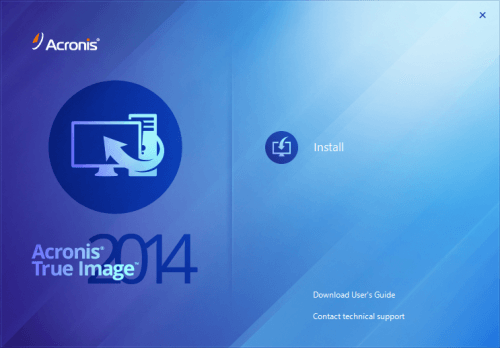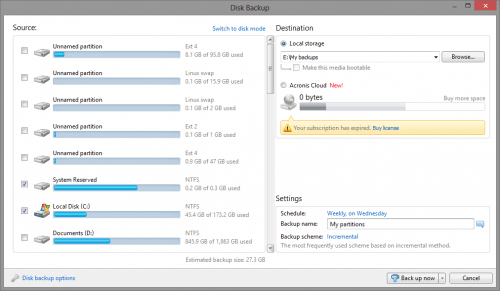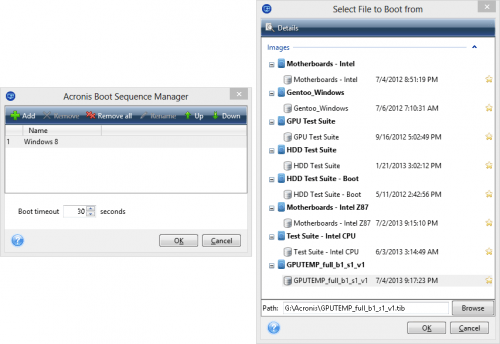- Qualcomm Launches Snapdragon 4 Gen 2 Mobile Platform
- AMD Launches Ryzen PRO 7000 Series Mobile & Desktop Platform
- Intel Launches Sleek Single-Slot Arc Pro A60 Workstation Graphics Card
- NVIDIA Announces Latest Ada Lovelace Additions: GeForce RTX 4060 Ti & RTX 4060
- Maxon Redshift With AMD Radeon GPU Rendering Support Now Available
Acronis True Image 2014 Review

The latest version of Acronis’ popular backup and recovery suite, True Image, has just been released, and once again, we’re taking a look at what’s new. We saw good integration of Acronis’ cloud service with last year’s True Image, but this year’s version takes things to an all-new level. Let’s check that out, along with all else that’s new.
Page 1 – Introduction, Acronis Cloud & Boot to .tib
With last year’s version of Acronis’ backup and recovery suite, True Image, the company amped-up the built-in support for its cloud service. After our testing, we were left impressed from both a cost and performance stand-point, and heartily recommended it to anyone who was looking for such a solution. If you haven’t noticed, cloud storage is becoming big business, and it’s all for good reasons.
With True Image 2014, Acronis is taking its cloud integration to an entirely new level. After taking a look at last year’s version, one complaint I had was being unable to save an entire image to the cloud, and well, that’s been completely remedied here with 2014.
Throughout this article, we’re going to take a look at some of the major features of the new version, and then wrap-up with a quick look at some other important features that Acronis has become well-known for.
Backing-up to the cloud
If you’ve been fortunate enough to avoid hearing the “cloud” buzzword before, it refers to “remote storage” – as in, your data being stored on a remote server, either one you own, or one you don’t. Over the past couple of years, many companies have begun offering their own spins on cloud storage, with Dropbox, Amazon, Google, and Microsoft being just some of the biggest players.
One of the best uses of cloud storage is backing your data up, so it was inevitable that Acronis would dip its feet into the pool (of storage… get it?) sooner than later. Thus, the company released Acronis Cloud in early 2011, and with each True Image release since then, built-in support has incrementally improved.
In 2014, the support for Acronis Cloud has been ramped up to the highest-levels, with every piece of data Acronis can back up being saveable to its cloud storage service – even complete PC backups. Obviously, backing up full images isn’t going to be for everyone, since only a 1 Gbps fiber optic connection would be able to match the speed of saving to an internal network or local storage – and that assumes the remote service you’re connecting to would even allow that kind of connection speed (hint: it won’t).
I’m not blessed with a fast Internet connection (0.5 Mbps upload), so I tend to avoid cloud services like the plague – this one included. Thus, I didn’t test out cloud backup with 2014. I have tested it out in the past, however, and have been pleased with the experience overall. On slower connections, it’s suitable to upload documents and photos, but if you’re planning to upload entire Acronis images, as pictured above, you’re going to need a fat pipe. Let’s do some quick math:
Time to Upload Acronis Image (25GB)
- 1 Mbps: 56.8 hours
- 5 Mbps: 11.4 hours
- 10 Mbps: 5.7 hours
- 20 Mbps: 2.8 hours
- 30 Mbps: 1.9 hours
- 1 Gbps: 0.06 hours
Hate those folks equipped with 1 Gbps Google Fiber yet? Bear in mind, though, that these values are based on theoretical maximums – they’re best case. As we all know too well, where tech is concerned, real values never equal “best case”. If ISPs were breweries, Budweiser would be their beer – heralded as the best thing on earth, but in reality…
Back to features: Just because the disk image is stored in the cloud, the ability to restore in increments is not lost. In effect, aside from the throughput speed, saving images to Acronis Cloud is no different from saving the data locally. Even if you have a beefy net connection, I’m not sure I’d really go this route myself, but backing them up there anyway in the event of a catastrophic failure is an interesting proposition.
As of the time of writing, Acronis offers the most competitive rates I can find for storage among the big four mentioned earlier. For 5GB per year, it’s $10; 50GB, $30; and 250GB, $50. While SkyDrive’s 50GB tier option is $5 less, it offers a mere 100GB for $50 – Dropbox costs $100/yr for the same. With that sort of pricing, it’s clear that Acronis would love for you to go all out – and honestly, $50 a year for 250GB is an impressive deal for remote storage – I’ve simply been unable to find a better price than this.
Boot to .tib with Windows 8.1 (and Win7 Ultimate + Enterprise)
Acronis has offered the ability to convert its .tib backup files into Microsoft’s favorite virtualized format, .vhd, for some time, which allows you to boot straight into the file via a hypervisor. With Windows 7 Ultimate and Enterprise, though, Microsoft removed the conversion hassle and allowed you to boot straight into the .tib – call it a perk of the higher-priced OS. With Windows 8, that feature was removed. Why? We can only imagine that it’s because an Ultimate version doesn’t exist. Foolish.
The functionality is returning to Windows 8.1, however, which is making an already good-looking OS release look even more attractive. At the moment, I have no Win7 Ultimate or 8.1 machines set up (somewhat unbelievably), so I was unable to test this feature. I have in the past, however, and have been pleased with its execution, although it’s mostly used to verify that a backup is perfect, or to test things out (it’s generally more convenient to do that in a virtual machine, however).
Support our efforts! With ad revenue at an all-time low for written websites, we're relying more than ever on reader support to help us continue putting so much effort into this type of content. You can support us by becoming a Patron, or by using our Amazon shopping affiliate links listed through our articles. Thanks for your support!








